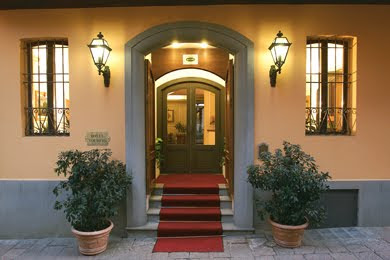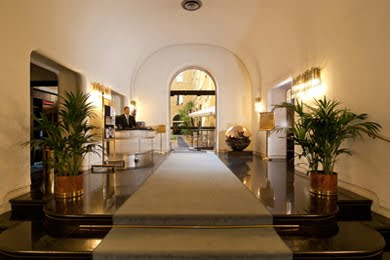 For all the glamour and hype of the Venice Film Festival in September, the cognoscenti visit the Lido in the comparatively tranquil month of August. Robin Saikia reports on a restful annual trip to the Excelsior, enlivened by some startling gossip about how Venice's elite successfully resisted some barbarous 'improvements' to its two great hotels.
For all the glamour and hype of the Venice Film Festival in September, the cognoscenti visit the Lido in the comparatively tranquil month of August. Robin Saikia reports on a restful annual trip to the Excelsior, enlivened by some startling gossip about how Venice's elite successfully resisted some barbarous 'improvements' to its two great hotels.
Late August is a perfect time to visit the Excelsior for a quiet interlude of uninterrupted self-indulgence before the Venice Film Festival. For a couple of unhurried weeks it is easy to see why this was Winston Churchill's favourite hotel in Venice. The combination, unusual for his time and ours, of spatial grandeur and patrician informality never fails to inspire creativity and revitalise frayed nerves. The Excelsior goes from strength to strength under the management of Leone Jannuzzi and his team. Long may it last.
The Lido is quiet in August, with very few foreign tourists in evidence. The beaches are populated by groups of impeccably behaved Italians enjoying a warm, temperate and peaceful Adriatic. Even with the pre-Festival hype, it is very nearly impossible to imagine this tranquillity being shattered in September as it is every year, when the Excelsior is packed to its minarets for a fortnight with stars, directors and their entourages.
A typical day in August might begin, as ours usually does, with an early morning walk or bicycle ride to Alberoni or San Nicolo, sufficiently bracing to appease the semi-dormant work ethic. The next step, when you've witnessed the sun rise and heard the dawn chorus, is a champagne breakfast at the Excelsior, a swim in either the sea or the pool and a stroll around the cluster of nearby art deco villas. Later the Tavernetta, the restaurant opposite the hotel, was sufficiently laid back this year for its owner to conjure up, after closing time, a late lunch of bruschetta and gnocchi. Afternoon tea at the golf club in Alberoni was entertaining, an agreeably eccentric amalgam of long-forgotten English, American and Italian values: ancient and unimpeachably shabby sofas and armchairs, cases of tarnished trophies, Ivy League-style honours boards, photos of the Duke of Windsor and Henry Ford - and distant but still unsettling reminders of Mussolini's meeting with Hitler here in the early Thirties. Back at the Lions Bar, in the early evening, there was nobody about but a dazed-looking barefoot blonde, possibly the ghost of a Fellini extra, dancing slowly back and forth under a massive glitterball. This is the time to check in at the Excelsior's Blue Bar, for there you will hear intriguing gossip about Venice.
There is plenty of it as the redevelopment of the Lido continues, a huge project largely underwritten by EST Capital in partnership with the Comune di Venezia. That night, in the bar, much was revealed by an affable group of Venetian businessmen about the future of the Hotel des Bains, which the British press had recently and wrongly reported as being under threat of permanent closure.
In reality, the inspiration for Thomas Mann's
Death in Venice is to be redeveloped as a smaller but no less luxurious hotel, a sizeable proportion of the old space to be reincarnated as luxury apartments, a sensible way of getting cash in without compromising historical integrity. That is, perhaps, the important news for everyone who was worried about the impending desecration of a much-loved old landmark, but what was truly intriguing were my Venetian friends' gleefully morbid accounts of the committee-driven feasibility studies that necessarily precede major developments like this.
For example, there was the question of the grand old mirrors in the ballroom of the Hotel des Bains, mirrors that in their time had reflected Coco Chanel and Isadora Duncan, not to mention Stravinsky at the piano, playing Diaghilev the opening bars of the Danse des Adolescents from the Rite of Spring. A youngster on the redevelopment committee had, it seems, suggested that the glass in these mirrors be replaced because it was "old, rotten and smoky". A new hotel needs spanking new glazing throughout, ran his thinking, so the old glass would have to go. The proposal was seconded by someone in the Italian equivalent of Health and Safety who expatiated on the dangers of even looking at antique mirrors. You might lose your footing, he claimed, or
worse.
Needless to say, none of this will happen - the reglazing proposal was overruled, because while the Italians are as bad as the Brits when it comes to getting embroiled in sterile committee work, they excel, unlike us, at ruling out appalling errors of taste at the last minute. Back at the Excelsior, for example, there was a terrifying interlude when the ballroom was at risk, not from Health and Safety this time, but from the recommendations of a consultant specialising in 'best practice' and 'facilities management'. The ballroom, known as the Sala degli Stucchi because of its exquisite and elaborate plaster cornices and cupids, was to have been carved up by gleeful accountants into a series of "cost-effective" conference spaces. Any inconveniently placed
putti were to be hacked off to make way for "versatile" room-divider fixings. The massive Umberto Bellotto chandeliers that had softened and dappled the silk and velvets of Fortuny frocks were to be wrenched out and replaced with 'site-specific' lighting. "They would have to kill me first," said a well known local man of considerable power and influence, and he meant it. And so the Sala degli Stucchi is safe. It is possible, in peaceful August, to wander into the vast space unchallenged and sit alone at one of the tables and meditate, or even tap away at some writing as I did, somewhat like Jack Nicholson in The Shining. Health and safety plus unlicensed cultural vandalism makes Jack a very angry boy...

































